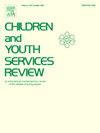Retrospective Childhood Emotional Maltreatment and Adolescent Problem Behaviors Trajectories: The Mediating Roles of Neuroticism and Self-Compassion
IF 2.4
2区 社会学
Q1 FAMILY STUDIES
引用次数: 0
Abstract
Despite growing awareness that early adverse experiences may shape adolescent problem behaviors, understanding of the longitudinal relationships and potential mechanisms between childhood emotional maltreatment and the developmental trajectories of adolescent problem behaviors remains limited. This study examined the longitudinal relationship between retrospective childhood emotional maltreatment and adolescent problem behaviors trajectories, considering the mediating roles of neuroticism and self-compassion. Participants were 1,214 Chinese adolescents (Mage = 15.46, SDage = 0.71, 60.70 % male) from a longitudinal design with three waves spanning six months. Adolescents reported their retrospective childhood emotional maltreatment (ages 6–12) at Time 1, as well as their current levels of neuroticism and self-compassion at Time 1. Problem behaviors were reported at Times 1, 2, and 3. Results showed that childhood emotional maltreatment was positively associated with the initial level of adolescent problem behaviors and negatively associated with its decreasing rate. Notably, neuroticism mediated the relationship between childhood emotional maltreatment and adolescent problem behaviors trajectories (both initial level and decreasing rate), and self-compassion mediated the association between childhood emotional maltreatment and the initial level of adolescent problem behaviors. These findings highlight that preventing and addressing adolescent problem behaviors requires integrated attention to environmental and individual factors.
回顾童年情绪虐待与青少年问题行为轨迹:神经质和自我同情的中介作用
尽管越来越多的人意识到早期不良经历可能会影响青少年的问题行为,但对童年情感虐待与青少年问题行为发展轨迹之间的纵向关系和潜在机制的理解仍然有限。本研究考察了回溯性童年情绪虐待与青少年问题行为轨迹的纵向关系,并考虑了神经质和自我同情的中介作用。研究对象为1214名中国青少年(Mage = 15.46, SDage = 0.71, 60.70%为男性),采用纵向设计,三波跨度为6个月。青少年报告了他们在时间1时的童年情感虐待(6-12岁),以及他们在时间1时的神经质和自我同情的当前水平。问题行为在第1次、第2次和第3次报告。结果表明,儿童时期的情绪虐待与青少年问题行为的初始水平呈正相关,与青少年问题行为的减少率呈负相关。其中,神经质在童年情绪虐待与青少年问题行为轨迹(初始水平和递减率)之间起中介作用,自我同情在童年情绪虐待与青少年问题行为初始水平之间起中介作用。这些发现强调,预防和解决青少年问题行为需要综合关注环境和个人因素。
本文章由计算机程序翻译,如有差异,请以英文原文为准。
求助全文
约1分钟内获得全文
求助全文
来源期刊

Children and Youth Services Review
Multiple-
CiteScore
6.30
自引率
6.10%
发文量
303
期刊介绍:
Children and Youth Services Review is an interdisciplinary forum for critical scholarship regarding service programs for children and youth. The journal will publish full-length articles, current research and policy notes, and book reviews.
 求助内容:
求助内容: 应助结果提醒方式:
应助结果提醒方式:


